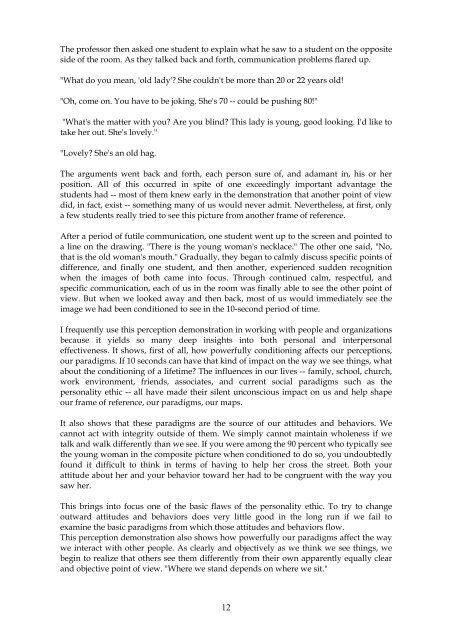Covey - The 7 habits of highly effective people
You also want an ePaper? Increase the reach of your titles
YUMPU automatically turns print PDFs into web optimized ePapers that Google loves.
<strong>The</strong> pr<strong>of</strong>essor then asked one student to explain what he saw to a student on the opposite<br />
side <strong>of</strong> the room. As they talked back and forth, communication problems flared up.<br />
"What do you mean, 'old lady'? She couldn't be more than 20 or 22 years old!<br />
"Oh, come on. You have to be joking. She's 70 -- could be pushing 80!"<br />
"What's the matter with you? Are you blind? This lady is young, good looking. I'd like to<br />
take her out. She's lovely."<br />
"Lovely? She's an old hag.<br />
<strong>The</strong> arguments went back and forth, each person sure <strong>of</strong>, and adamant in, his or her<br />
position. All <strong>of</strong> this occurred in spite <strong>of</strong> one exceedingly important advantage the<br />
students had -- most <strong>of</strong> them knew early in the demonstration that another point <strong>of</strong> view<br />
did, in fact, exist -- something many <strong>of</strong> us would never admit. Nevertheless, at first, only<br />
a few students really tried to see this picture from another frame <strong>of</strong> reference.<br />
After a period <strong>of</strong> futile communication, one student went up to the screen and pointed to<br />
a line on the drawing. "<strong>The</strong>re is the young woman's necklace." <strong>The</strong> other one said, "No,<br />
that is the old woman's mouth." Gradually, they began to calmly discuss specific points <strong>of</strong><br />
difference, and finally one student, and then another, experienced sudden recognition<br />
when the images <strong>of</strong> both came into focus. Through continued calm, respectful, and<br />
specific communication, each <strong>of</strong> us in the room was finally able to see the other point <strong>of</strong><br />
view. But when we looked away and then back, most <strong>of</strong> us would immediately see the<br />
image we had been conditioned to see in the 10-second period <strong>of</strong> time.<br />
I frequently use this perception demonstration in working with <strong>people</strong> and organizations<br />
because it yields so many deep insights into both personal and interpersonal<br />
<strong>effective</strong>ness. It shows, first <strong>of</strong> all, how powerfully conditioning affects our perceptions,<br />
our paradigms. If 10 seconds can have that kind <strong>of</strong> impact on the way we see things, what<br />
about the conditioning <strong>of</strong> a lifetime? <strong>The</strong> influences in our lives -- family, school, church,<br />
work environment, friends, associates, and current social paradigms such as the<br />
personality ethic -- all have made their silent unconscious impact on us and help shape<br />
our frame <strong>of</strong> reference, our paradigms, our maps.<br />
It also shows that these paradigms are the source <strong>of</strong> our attitudes and behaviors. We<br />
cannot act with integrity outside <strong>of</strong> them. We simply cannot maintain wholeness if we<br />
talk and walk differently than we see. If you were among the 90 percent who typically see<br />
the young woman in the composite picture when conditioned to do so, you undoubtedly<br />
found it difficult to think in terms <strong>of</strong> having to help her cross the street. Both your<br />
attitude about her and your behavior toward her had to be congruent with the way you<br />
saw her.<br />
This brings into focus one <strong>of</strong> the basic flaws <strong>of</strong> the personality ethic. To try to change<br />
outward attitudes and behaviors does very little good in the long run if we fail to<br />
examine the basic paradigms from which those attitudes and behaviors flow.<br />
This perception demonstration also shows how powerfully our paradigms affect the way<br />
we interact with other <strong>people</strong>. As clearly and objectively as we think we see things, we<br />
begin to realize that others see them differently from their own apparently equally clear<br />
and objective point <strong>of</strong> view. "Where we stand depends on where we sit."<br />
12


